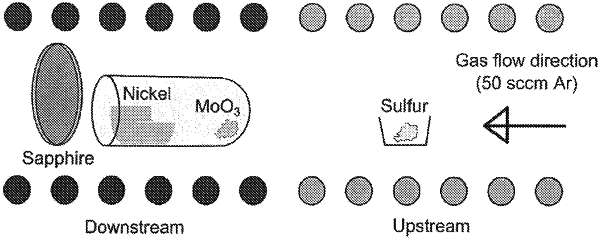| CPC C23C 16/305 (2013.01) [C23C 16/4401 (2013.01); C23C 16/4481 (2013.01); C23C 16/455 (2013.01)] | 8 Claims |

|
1. An arrangement for forming a transition metal dichalcogenide layer on a substrate, the arrangement comprising:
a chamber for containing a transition metal oxide and a non-gaseous chalcogen scavenger, wherein the non-gaseous chalcogen scavenger is disposed in proximity to the transition metal oxide;
a heating zone at which a chalcogen source is placed;
a substrate holder adapted to have a substrate positioned downstream of the chamber so as to have the substrate disposed downstream of the transition metal oxide and the chalcogen source; and
an inert gas source adapted to provide an inert gas flow towards the substrate holder, wherein the heating zone is positioned to have the chalcogen source disposed in a path of the inert gas flow from the inert gas source towards the substrate holder;
wherein the chamber has a closed end and an opening opposite to the closed end, wherein the opening is adapted to have the non-gaseous chalcogen scavenger disposed at the opening and in the chamber and 10 cm or less away from the transition metal oxide, and wherein the closed end is configured as a physical barrier which is (i) disposed between the transition metal oxide and the chalcogen source, (ii) adapted to have the transition metal oxide disposed at the closed end of the chamber, (iii) adapted to prevent the inert gas flow from directly contacting the transition metal oxide and the non-gaseous chalcogen scavenger.
|